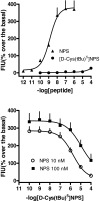In vitro and in vivo pharmacological characterization of the neuropeptide s receptor antagonist [D-Cys(tBu)5]neuropeptide S
- PMID: 18971372
- PMCID: PMC2630366
- DOI: 10.1124/jpet.108.143867
In vitro and in vivo pharmacological characterization of the neuropeptide s receptor antagonist [D-Cys(tBu)5]neuropeptide S
Abstract
Neuropeptide S (NPS) was identified as the endogenous ligand of an orphan receptor now referred to as the NPS receptor (NPSR). In the frame of a structure-activity study performed on NPS Gly5, the NPSR ligand [D-Cys(tBu)(5)]NPS was identified. [D-Cys(tBu)(5)]NPS up to 100 microM did not stimulate calcium mobilization in human embryonic kidney (HEK) 293 cells stably expressing the mouse NPSR; however, in a concentration-dependent manner, the peptide inhibited the stimulatory effects elicited by 10 and 100 nM NPS (pK(B), 6.62). In Schild analysis experiments [D-Cys(tBu)(5)]NPS (0.1-100 microM) produced a concentration-dependent and parallel rightward shift of the concentration-response curve to NPS, showing a pA(2) value of 6.44. Ten micromolar [D-Cys(tBu)(5)]NPS did not affect signaling at seven NPSR unrelated G-protein-coupled receptors. In the mouse righting reflex (RR) recovery test, NPS given at 0.1 nmol i.c.v. reduced the percentage of animals losing the RR in response to 15 mg/kg diazepam and their sleeping time. [d-Cys(tBu)(5)]NPS (1-10 nmol) was inactive per se but dose-dependently antagonized the arousal-promoting action of NPS. Finally, NPSR-deficient mice were similarly sensitive to the hypnotic effects of diazepam as their wild-type littermates. However, the arousal-promoting action of 1 nmol NPS could be detected in wild-type but not in mutant mice. In conclusion, [D-Cys(tBu)(5)]NPS behaves both in vitro and in vivo as a pure and selective NPSR antagonist but with moderate potency. Moreover, using this tool together with receptor knockout mice studies, we demonstrated that the arousal-promoting action of NPS is because of the selective activation of the NPSR protein.
Figures





Similar articles
-
[tBu-D-Gly5]NPS, a pure and potent antagonist of the neuropeptide S receptor: in vitro and in vivo studies.Peptides. 2012 Apr;34(2):404-11. doi: 10.1016/j.peptides.2012.01.024. Epub 2012 Feb 9. Peptides. 2012. PMID: 22342393
-
In vitro and in vivo pharmacological characterization of the novel neuropeptide S receptor ligands QA1 and PI1.Peptides. 2013 Oct;48:27-35. doi: 10.1016/j.peptides.2013.07.018. Epub 2013 Jul 30. Peptides. 2013. PMID: 23911665
-
Synthesis and biological activity of human neuropeptide S analogues modified in position 5: identification of potent and pure neuropeptide S receptor antagonists.J Med Chem. 2009 Jan 22;52(2):524-9. doi: 10.1021/jm8012294. J Med Chem. 2009. PMID: 19113861 Free PMC article.
-
Neurobiology, pharmacology, and medicinal chemistry of neuropeptide S and its receptor.Med Res Rev. 2010 Sep;30(5):751-77. doi: 10.1002/med.20180. Med Res Rev. 2010. PMID: 19824051 Review.
-
Neuropeptide S receptor ligands: a patent review (2005-2016).Expert Opin Ther Pat. 2017 Mar;27(3):347-362. doi: 10.1080/13543776.2017.1254195. Epub 2016 Nov 9. Expert Opin Ther Pat. 2017. PMID: 27788040 Review.
Cited by
-
Neuropeptide S: a novel regulator of pain-related amygdala plasticity and behaviors.J Neurophysiol. 2013 Oct;110(8):1765-81. doi: 10.1152/jn.00874.2012. Epub 2013 Jul 24. J Neurophysiol. 2013. PMID: 23883857 Free PMC article.
-
Pharmacological profile of the neuropeptide S receptor: Dynamic mass redistribution studies.Pharmacol Res Perspect. 2018 Dec 3;6(6):e00445. doi: 10.1002/prp2.445. eCollection 2018 Dec. Pharmacol Res Perspect. 2018. PMID: 30534379 Free PMC article.
-
Molecular evolution of the neuropeptide S receptor.PLoS One. 2012;7(3):e34046. doi: 10.1371/journal.pone.0034046. Epub 2012 Mar 30. PLoS One. 2012. PMID: 22479518 Free PMC article.
-
Neuropeptide S facilitates cue-induced relapse to cocaine seeking through activation of the hypothalamic hypocretin system.Proc Natl Acad Sci U S A. 2010 Nov 9;107(45):19567-72. doi: 10.1073/pnas.1004100107. Epub 2010 Oct 25. Proc Natl Acad Sci U S A. 2010. PMID: 20974945 Free PMC article.
-
Neuropeptide S: a transmitter system in the brain regulating fear and anxiety.Neuropharmacology. 2010 Jan;58(1):29-34. doi: 10.1016/j.neuropharm.2009.06.001. Epub 2009 Jun 10. Neuropharmacology. 2010. PMID: 19523478 Free PMC article. Review.
References
-
- Ahnaou A, Drinkenburg W, Huysmans H, Heylen A, Steckler T, and Dautzenberg F (2006) Differential roles of hypothalamic neuropeptides in sleep-wake modulation in rats. Soc Neurosci Abstr 32 458.1/CC11.
-
- Allen IC, Pace AJ, Jania LA, Ledford JG, Latour AM, Snouwaert JN, Bernier V, Stocco R, Therien AG, and Koller BH (2006) Expression and function of NPSR1/GPRA in the lung before and after induction of asthma-like disease. Am J Physiol Lung Cell Mol Physiol 291 L1005-L1017. - PubMed
-
- Beck B, Fernette B, and Stricker-Krongrad A (2005) Peptide s is a novel potent inhibitor of voluntary and fast-induced food intake in rats. Biochem Biophys Res Commun 332 859-865. - PubMed
-
- Bernier V, Stocco R, Bogusky MJ, Joyce JG, Parachoniak C, Grenier K, Arget M, Mathieu MC, O'Neill GP, Slipetz D, et al. (2006) Structure-function relationships in the neuropeptide S receptor: molecular consequences of the asthma-associated mutation N107I. J Biol Chem 281: 24704-24712. - PubMed
-
- Bingham MJ, Cai J, and Deehan MR (2006) Eating, sleeping and rewarding: orexin receptors and their antagonists. Curr Opin Drug Discov Dev 9 551-559. - PubMed
Publication types
MeSH terms
Substances
Grants and funding
LinkOut - more resources
Full Text Sources
Molecular Biology Databases
Miscellaneous

